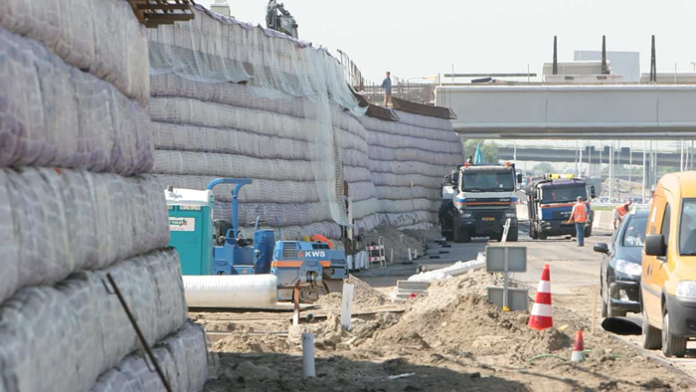While bridge and pavement conditions receive much of the media attention and legislative directives for transportation agencies, the value and performance of other assets are also important to the life-cycle operation of the transportation system. Geotechnical assets represent one such category. These assets include walls, slopes, embankments, and subgrades that contribute to the ability of a transportation agency to perform the strategic mission. In this latest publication in our series of articles from the GAP 2019 transportation engineering conference proceedings, Mark Vessely, P.E. shares geotechnical asset management insight rooted in international examples and his own experiences from private practice and public agency work. ABOUT THE FEATURE IMAGE: A reinforced soil wall along an infrastructure project. Photo by NAUE. These structures create enormous value for their owners. If managed as geotechnical assets, they can yield even greater value for an infrastructure in the long term, Vessely writes.
1. INTRODUCTION TO GEOTECHNICAL ASSET MANAGEMENT
Above all, asset management is a business process for asset owners to maximize the value of their assets and make risk informed decisions that align with the objectives and goals of the organization. Thus, through asset management private and public organizations can demonstrate both financial stewardship to investors or the enabling taxpayers and increase the likelihood services provided to customers and users of the system are acceptable over time. Legislative authorization or regulations do not need to be the primary initiator of asset management as evidenced by the British Standards Institute (BSI) work on standardization of asset management, which was first published in 2004 with more than 50 public and private entities spanning 10 countries and 15 sectors contributing to development (BSI, 2008). The BSI work was later adopted and superseded by the International Standards Organization (ISO), leading to the current ISO 55000 series on asset management.
According to the Federal Highway Administration (2018), “transportation asset management plans are an essential management tool which bring together all related business processes and stakeholders, internal and external, to achieve a common understanding and commitment to improve performance.” The current obligatory requirements of Federal highway authorization require the continued management of bridge and pavement assets and encourage inclusion of other assets into asset management plans. One such asset class that can be considered are geotechnical assets.
Geotechnical asset are the retaining walls, embankments, slopes, and constructed subgrades within a transportation system right-of-way (ROW) or easement. Like other asset categories, geotechnical assets are features that are designed, constructed, and maintained by a transportation agency and their performance – good or poor – contributes to the continuous operation of a transportation network. Geotechnical assets are also subject to deterioration and exposed to natural hazards similar to other assets.
MORE FROM GAP: Unsaturated Analysis of Water Flow in Granular Layers of Inundated Pavements
Implementing asset management practices for geotechnical assets enables an agency to measure and manage the life-cycle investment considering performance expectations and tolerance for risk. The reasons for geotechnical asset management (GAM) are comparable to any other business practice that is directed at making smart investments with limited funds. Without geotechnical asset management, transportation owners are accepting unknown levels of risk to objectives related to safety, service, and economic vitality, and may also be making unfavorable life-cycle investments.
The value of geotechnical asset management was realized by the Transportation Research Board and National Highway Cooperative Research (NCHRP) program through the commissioning of NCHRP Study 24-26: “Development of an Implementation Manual for Geotechnical Asset Management for Transportation Agencies.” The outcome of this study, NCHRP Research Report 903 includes an implementation manual with supporting software tools for transportation executives, asset managers, and geotechnical practitioners to initiate asset management for walls, slopes, and embankments.
2. DEFINING GEOTECHNICAL ASSETS
The ISO 55000 definition of an asset states: an item, thing or entity that has potential or actual value to an organization; value can be tangible or intangible, financial or non-financial, and includes consideration of risks and liabilities (ISO, 2018).
Separately, the AASHTO transportation asset management guide: a focus on implementation (2011) defines an “asset” as the physical transportation infrastructure (e.g., travel way, structures, other features and appurtenances, operations systems, and major elements thereof); more generally, can include the full range of resources capable of producing value-added for an agency: e.g., human resources, financial capacity, real estate, corporate information, equipment and materials, etc.; an individual, separately-managed component of the infrastructure, e.g., bridge deck, road section, streetlight. Thus, in both definitions transportation assets consist of the many physical assets that add value to the transportation system and can impact the ability of the organization to satisfy executive level performance objectives,
One such category of assets is those comprised of earth (soil and rock), or a geotechnical asset, with the adjective ‘geotechnical’ describing constructed earth materials. Examples of geotechnical assets include the retaining walls, embankments, slopes, or constructed subgrades that contribute to the performance of a transportation system and are located within the right-of-way or boundary. Geotechnical assets also contribute to the performance of the culverts, stormwater drainage systems, and utilities that are often contained within the asset.
The presented definition of geotechnical assets is not unique to the U.S., as slopes and embankments are defined as geotechnical assets for highway and railway systems in the United Kingdom (U.K.) and have been managed as part of asset management programs for over a decade. Additionally, there often are situations where multiple geotechnical assets exist the same unit length of road or railway, such as a retaining wall on the downslope side of a corridor and slopes on the uphill side. Thus, agencies can have substantial inventories of geotechnical assets, and in many cases may have more retaining walls than bridges.
Additional discussion on the definition of geotechnical assets is presented in the following subsections.
2.1 Retaining Walls
Retaining walls, or earth retaining structures, are structures that hold back soil and/or rock materials to prevent sliding of material onto a transportation corridor or retain material that supports other transportation assets. Retaining walls can include many types of walls, including gravity walls, soil nail walls, concrete cantilever structures, or mechanically stabilized earth (MSE) walls. Retaining walls generally have vertical or near vertical faces. The recommended height for incorporation into an asset management inventory is 4 feet, which is similar to the height that defines a retaining wall in the engineering design process. Photographs of retaining wall assets are shown in Figure 1.
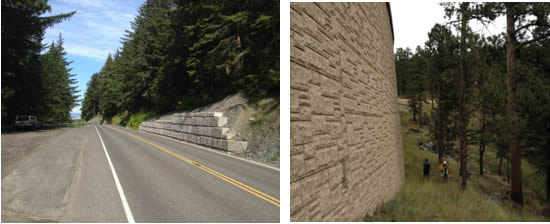
In many cases, a retaining wall is associated with a bridge structure or approach to a bridge. If a wall is also a bridge abutment that is integral to the bridge structure, the wall likely will be incorporated into a separate bridge inspection and asset management program. However, all other walls associated with the bridge approaches should be incorporated into a geotechnical asset management program if not already managed in an asset management program, which is often the situation.
2.2 Embankments
An embankment asset consists of a constructed fill comprised of rock, soil, or other engineered materials that enables a roadway, railway, or other transportation facility to maintain a required design elevation above lower lying ground. A threshold embankment height of 10 feet (3 m) is recommended as delineation between a minor earthwork and an embankment asset, unless there are site conditions or criticality may merit a lower height. The 10-foot recommended height for an embankment is based the implementation experience for 240,000 geotechnical assets on highways and railways throughout the United Kingdom (NASEM, 2019). A schematic of embankment assets is provided in Figure 2.
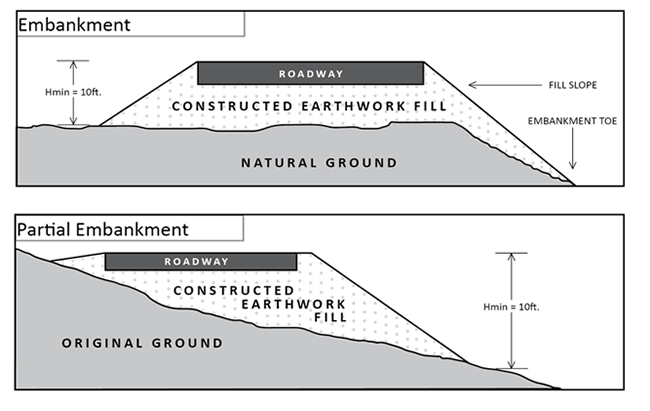
2.3 Slopes
Slopes are a type of geotechnical asset involving cut excavations that enable a roadway or railway to traverse through surrounding ground, as shown in Figure 3. Slopes also may include natural slopes adjacent to a roadway for some agencies. Slopes differ from embankments in that slopes are excavated into terrain rather than a constructed fill feature or may consist of a natural slope. Slopes can consist of soil, rock, and mixtures of soil and rock as illustrated in Figure 3. Similar to embankment assets, a 10-foot threshold for cut slope height is recommended, unless the asset is judged to create an unacceptable hazard to the safety of users and maintenance personnel.
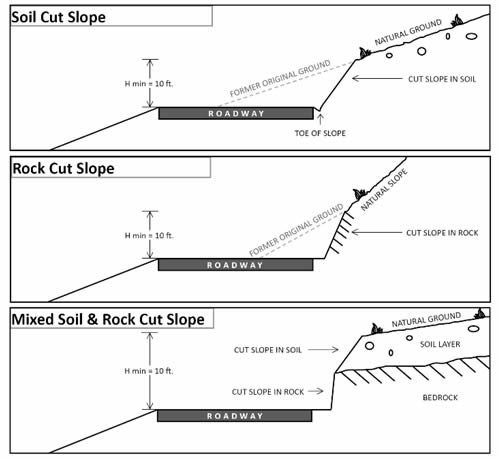
2.4 Subgrades
Subgrade assets consist of earth materials below the engineered pavement or railway that creates a life-cycle management need. Examples of subgrade assets include constructed earthworks and ground improvements to address weak foundation soil, swelling, frozen or thawing ground, and collapsible soil or threats from karst (sinkholes) and underground mining. Examples of subgrade assets are illustrated in Figure 4.
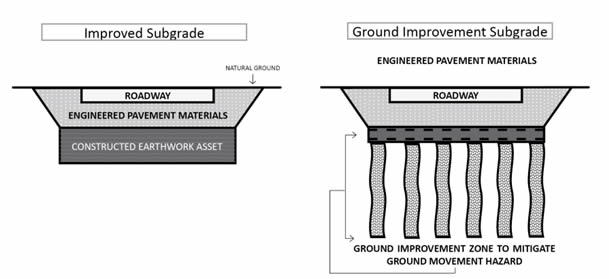
2.5 Taxonomy for Geotechnical Assets
The taxonomy for geotechnical assets was introduced by Anderson et al. (2016) and further developed in the NCHRP Research Report 903 (NASEM, 2019). The geotechnical asset taxonomy is based on common definitions used in professional geotechnical practice and with the intent of aligning with the state of practice with transportation asset management. This taxonomy is similar in structure to the general GAM taxonomy used by Highways England and Network Rail, allowing U.S. practice to connect with international practice. As noted by Anderson et al. (2016), the purpose of this taxonomy is to clarify language and ideas so that geotechnical engineers, other disciplines, and asset managers can communicate effectively within one organization and between different ones.
2.5.1 Role of Right-of-Way
Established transportation assets, such as bridges and pavements, are easily recognized as being within the ROW or easement boundaries of an organization and often with ample buffer space from boundaries. For these assets, the agency has control over how they are built, maintained, and managed, in addition to full access rights. Geotechnical assets also exist within the agency boundaries and many geotechnical assets often extend right to the ROW boundary, or beyond. It is not uncommon that the limits of disturbed area associated with a slope or embankment asset will define the ROW or easement boundary for the agency and retaining walls often have the function of minimizing ROW disturbance and thus are constructed at the boundary. In such conditions, there is potential for adverse consequences to external property stakeholders beyond the ROW from an agency geotechnical asset, which is different performance threat when compared to a pavement asset.
MORE FROM GAP: Assessment of Historical Army Airfield Pavement Condition Data
There also can be geotechnical features outside of the right-of-way or boundary that are not owned by the agency. These features often consist of location specific hazards associated with a natural slope that threatens other transportation assets or the agency performance. Examples of these features may include rockfall from geologic outcrops, landslides that originate beyond the boundary, or private retaining walls, often common in urban areas, that can impact agency assets. Historically, many agencies have assumed the responsibility for the response to events originating from geotechnical features beyond the ROW boundary. However, the access and ownership constraints limit the ability of an agency to manage these sites using the same design, maintenance, rehabilitation, or replacement treatment concepts applied to geotechnical assets in the ROW.
Given this ownership distinction, the taxonomy for geotechnical assets uses a separate category for geotechnical features or natural hazard sites that are beyond the ROW. Through this taxonomy distinction, an agency can choose whether to include geotechnical features beyond the ROW in a geotechnical asset management program or to defer to other programs, such as enterprise wide risk and resilience strategies that address other external agency hazards such as flooding, earthquake, or terror events. In such an example, having an inventory of beyond the ROW geotechnical features can be beneficial.
2.5.2 Geotechnical Elements within other Assets
Bridges, tunnels, and pavements contain geotechnical visual elements or hidden components, such as foundations and ground reinforcements, that enable the function of that specific asset. As indicated by Anderson et al. (2016), these other asset groups already have asset management practices to comply with Federal requirements and it is important to recognize the contribution of the geotechnical elements to these other assets, and to manage them through the existing platforms, and not create something new.
For the geotechnical elements and components of other structure assets (e.g., bridges and tunnels), those items can be identified as such, or using the exact terms already used within the given asset specific asset taxonomy. As an example, the foundations of a bridge comprise a portion of the bridge substructure component and are geotechnical items within an already managed asset.
2.5.3 Geotechnical Assets
Figure 5 presents the hierarchy used to classify embankments, slopes, retaining walls, and subgrades into the geotechnical asset class. For each of these assets, they have geotechnical composition and can be shown to measurably contribute to the value of an agency. Separately, there may be inventory and/or management systems that address one or a few of these geotechnical asset or feature types, particularly those identified as having progressed to an unstable condition. For example, the Rockfall Hazard Rating System (RHRS) was developed in the 1980s by the Oregon Department of Transportation with support from FHWA and other states (Pierson, 1991) to prioritize rockfall hazards from slopes within and beyond the ROW and has since been adopted or modified by transportation organizations with some including other unstable slope types. While slope and embankment assets can share characteristics those with in these legacy hazard management systems, it also is possible to integrate these sites into the broader geotechnical asset category and the risk-based asset management approach.
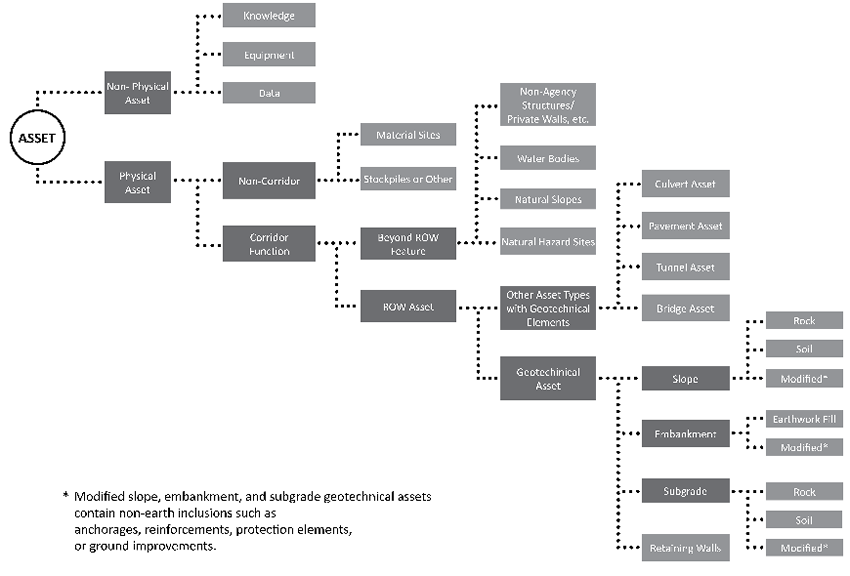
3. BENEFITS OF GEOTECHNICAL ASSET MANAGEMENT
When geotechnical assets are managed in a proactive, whole-life asset management approach, there can be benefits that include life-cycle cost savings; the capability to measure, communicate and manage risk; reduce operational disruptions; and fewer emergency stabilization projects that draw from contingency budgets. Based on outcomes from successful programs in transportation and other infrastructure systems, the benefits of performing asset management on walls, slopes, embankments, and subgrades can be summarized as follows.
- Financial savings across the life-cycle, with values estimated to be greater than 30% in studies by the U.S. Army Corps of Engineers (USACE, 2013), and 60 to 80% per embankment in the United Kingdom (Perry and others, 2003)
- Measure and manage safety risk exposure across the asset class and with a comparison to other assets
- Lessens traveler delay and closure times
- Reduces adverse economic impacts to connected communities
- Optimize resources, improves sustainability, and reputations
- Enables data driven decisions that support agency and executive objectives
- Understand the risk exposure across objectives and the ability to manage those risks
3.1 Scaling Implementation to Realize Benefits
Asset management is an on-going process that relies on process improvements to direct advancement where the greatest value can occur. When implementing asset management, each organization can adapt the fundamental concepts to the needs and objectives of their agency. Per the AASHTO Transportation Asset Management Guide (ex summary 2011): “There is no “one-size-fits-all” TAM solution for an agency.” Thus, geotechnical asset management does not need to be funded as a substantial new program, but rather can evolve to the needs and objectives of the organization.
When viewing the implementation history for bridge and pavement assets, each program has evolved from startup programs into more complex maturities that demonstrate measurable benefits. In the case of bridge and pavement asset management programs in the U.S., many municipal agencies have adopted the practices without being required because of the obvious benefits that result. Additionally, the benefits of asset management can be realized before an inventory is complete as evidenced by several years of implementation experience for both Network Rail and Highways England in the United Kingdom (NASEM, 2019). Through these examples, owners of geotechnical assets are encouraged to begin asset management as a complete process that locates early value gains, rather than focusing individually on each step in asset management.
Data collection for inventory and condition can become a time and cost intensive process and the investment in data collection should be compared against the required level of detail for decision support. As stated in the International Infrastructure Management Manual (IIMM) “a rule of thumb is often 80% of the data can be collected for half the cost of 100%. Seeking 100% coverage and accuracy may not be justified, except for the most critical assets” (IIMM, 2015). Following this guidance when starting geotechnical asset management, agencies can benefit from an approach that relies on different levels of detail and collection tools for inventory and condition data.
Per the IIMM (2015), a staged approach is the most practical process for data collection and begins with identification of minimum data for compliance and reporting requirements, next moves to data for prioritizing operations and maintenance decisions, and then concludes with optimizing life-cycle decisions. As discussed in Power et al. (2012), a similar progression to data collection occurred with geotechnical asset management for the U.K. Highway Agency. Within this staged data workflow, not all assets will necessary go to the final data collection level and reaching the most detailed data state occurs only where justified.
3.2 Measuring Performance in the Context of Asset Management
The goal of any asset management system is to logically align asset design, operation, maintenance, and upgrade decisions with agency goals and objectives. For asset management to succeed across an organization, the program should relate how asset performance affects customers and decisions by executives that are centered on agency goals and objectives. For this to occur, asset performance measures should relate to high-level agency objectives, such as common safety and system performance objectives.
The performance measurement for geotechnical assets can connect with objectives related to Federal Authorization and other common executive benchmarks found in agency mission and vision statements. Through such measurement, the geotechnical asset manager can track and communicate levels of risk, preservation need, or other factors that enable decision makers understand geotechnical assets in the context of agency specific goals. For communicating and measuring implementation benefits in a simple means, geotechnical asset performance measures should be generalized and high-level while still being effective at measuring performance relative to outward objectives and informing decisions.
Lessons learned from mature geotechnical asset management programs and input from agency executives indicates that successfully adopted performance measures are those that relate how the asset performance affects customers or executive decision making. As an example, Network Rail geotechnical asset are assessed with the following measures (Network Rail, 2017):
- train derailments,
- train delay minutes,
- temporary train speed reductions, and
- earthwork failures.
As presented in NASEM (2019), these approaches have been developed into a geotechnical asset level of risk (LOR) measure that connects to objectives related to asset condition, safety impacts, mobility, and economic consequences, which are common objectives across DOTs and means for connecting geotechnical asset performance to stakeholder goals and objectives.
3.3 Life-Cycle Planning and Return on Investment
Across assets types, asset management informs decisions throughout the life-cycle phases of design, construction, operation and maintenance, and decommissioning. For this to occur, asset management decisions will assess the following:
- total cost of the asset over the life, or life-cycle cost,
- risk across the life-cycle, and
- Financial and investment plans for multiple assets over a life-cycle.
To evaluate the life-cycle cost and risk from geotechnical assets and complete financial planning steps, organizations will need to optimize treatments that should be performed on an asset following initial construction. This optimization process should include the cost of each treatment, the appropriate timing for treatment, and what effect treatment has on the condition of asset. Basic treatments for geotechnical assets include:
- Do Minimum,
- Maintenance,
- Rehabilitation, and
- Renewal or Reconstruction.
Through geotechnical asset management, owners of geotechnical assets can make risk-informed treatment plans for their assets that have the benefit of minimizing life-cycle costs and managing risk to levels that are acceptable to the organization. Additionally, treatment decisions should consider the return on investment using benefit-cost analyses to estimate parameters such as net present value (NPV) or benefit cost ratio (BCR), The recently released Geotechnical Asset Management for Transportation Agencies, Volume 2: Implementation Manual (NASEM, 2019) provides guidance and includes tools for organizations to evaluate life-cycle costs and optimize treatment planning decisions for their geotechnical assets.
4. IMPLEMENTATION GUIDANCE TOOLS
To assist transportation organizations with geotechnical asset management, the Transportation Research Board commissioned NCHRP Study 24-46 which developed the recently released NCHRP Research Report 903: Geotechnical Asset Management for Transportation Agencies (NCHRP Report 903). NCHRP Report 903 provides an introduction to geotechnical asset management and adaptable guidance for to implementing risk-based geotechnical asset management into the broader practice of asset management. Volume 2 of the report contains an implementation manual with recommended processes and Microsoft Excel spreadsheet tools that can be of immediate use.
The geotechnical asset management process in NCHRP Report 903 aligns with established transportation asset management practices, including the following steps
- Objectives and Measures
- Inventory and Condition
- Performance Gap Identification
- Life-Cycle Cost and Risk Management Analysis
- Financial Plan
- Investment Strategies
To facilitate implementation, the processes and tools are purposely simple and can be used by engineering or asset management staff, or other agency professionals such as maintenance managers and bridge inspectors. As part of starting geotechnical asset management in a resource limited organization, agencies are encouraged to use and adapt data from existing inventories and begin with desktop approaches for an inexpensive inventory development. These data can be input into an inventory and assessment spreadsheet that accompanies NCHRP Report 903 and will provide initial recommendations for asset treatment types, enabling an agency to evaluate 10-year financial planning horizons.
Similar to existing asset management programs for pavements and bridges, the estimated program level investment needs for geotechnical assets across an agency will likely exceed the available funds. Therefore, the implementation manual contains additional processes for considering risk management, risk prioritization, and life-cycle cost investment prioritization approaches at the asset level. These different prioritization approaches are intended to address critical investment needs while also being flexible to the range in objectives that exist among executive and planning staff in different organizations.
5. CONCLUSION
Owners of geotechnical assets – the retaining walls, embankments, slopes, and subgrades that support or protect other transportation assets – are encouraged to incorporate these assets into the broader agency wide asset management planning strategy. Evidence from other industries and countries suggests sustaining benefits are possible based on information from organizations that have been performing geotechnical asset management for well over a decade. When the examples of life-cycle and risk management improvements are extrapolated nationwide to all state DOTs, railway and transit organizations, and local jurisdictions, the benefits from geotechnical asset management can be measurable and substantial. As there is a cost to delaying implementation, simply beginning asset management for a few geotechnical assets can be beneficial and is recommended over postponing implementation because of the absence of legislative or regulatory requirements.
To address the need and enable transportation organizations recognize the potential value, NCHRP Report 903 provides implementation guidance and tools that can be used now by organizations to manage geotechnical assets in a flexible and adaptable process.
ABOUT THE AUTHOR
Mark Vessely, P.E., is a Principal Engineer with BGC Engineering, Inc., in the company’s Golden, Colorado, USA office.
REFERENCES
AASHTO. 2011. AASHTO Transportation Asset Management Guide: A Focus on Implementation. American Association of Highway and Transportation Officials, Washington, D.C.
Anderson, S. A., V. R. Schaefer, and S. C. Nichols. 2016. “Taxonomy for Geotechnical Assets, Elements, and Features.” In: Transportation Research Board 95th Annual Meeting: Compendium of Papers. Transportation Research Board of the National Academies, Washington, D.C.
British Standards Institution (BSI). (2008). PAS 55-1:2008: Asset Management, Part 1: Specification for the Optimized Management of Physical Assets. BSI: London, England.
Federal Highway Administration (FHWA). 2018. Transportation Asset Management Plans. FHWA website: https://www.fhwa.dot.gov/asset/plans.cfm (accessed January 15, 2018).
Institute of Public Works Engineering Australasia. 2015. International Infrastructure Management Manual, 5th ed. National Asset Management Steering (NAMS) Group, Wellington, NZ.
International Standards Organization (ISO). 2018. ISO 55000:2014(en). Asset Management—Overview, Principles, and Terminology. ISO website https://www.iso.org/obp/ui/#iso:std:iso:55000:ed-1:v2:en:term:3.2.1 (accessed January 15, 2018).
National Academies of Sciences, Engineering, and Medicine 2019. Geotechnical Asset Management for Transportation Agencies, Volume 2: Implementation Manual. Washington, DC: The National Academies Press. https://doi.org/10.17226/25364
Network Rail, 2017. Earthworks Asset Policy (March 2017). Network Rail Infrastructure Limited.
Pierson, L. A. 1991. The Rockfall Hazard Rating System. Oregon Department of Transportation, Salem, OR.
Power, C., D. Patterson, D. Rudrum, D. Wright. 2012. “Geotechnical Asset Management for the UK Highways Agency.” In: Radford, T. A. (ed.). Earthworks in Europe. Geological Society, Engineering Geology Special Publication 26, London, United Kingdom. DOI: 10.1002/gj.2667.
U.S. Army Corps of Engineers (USACE). 2013. Best Practices in Asset Management. Report 2013-R-08. Institute for Water Resources, U.S. Army Corps of Engineers, Alexandria, VA.
